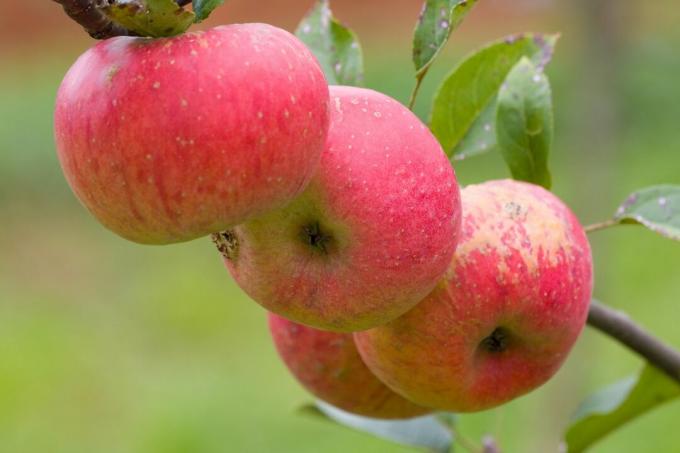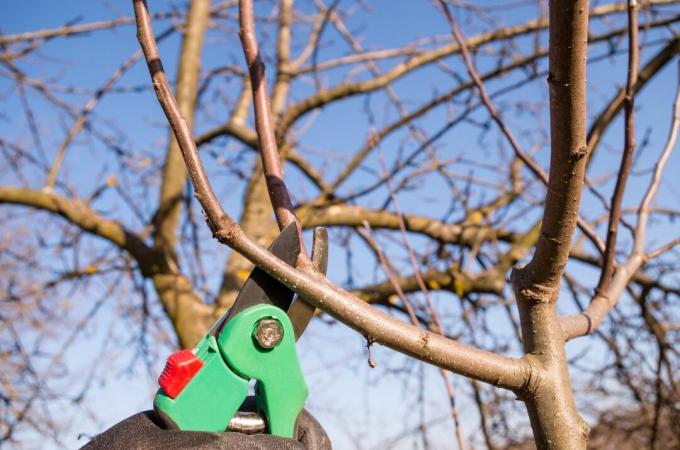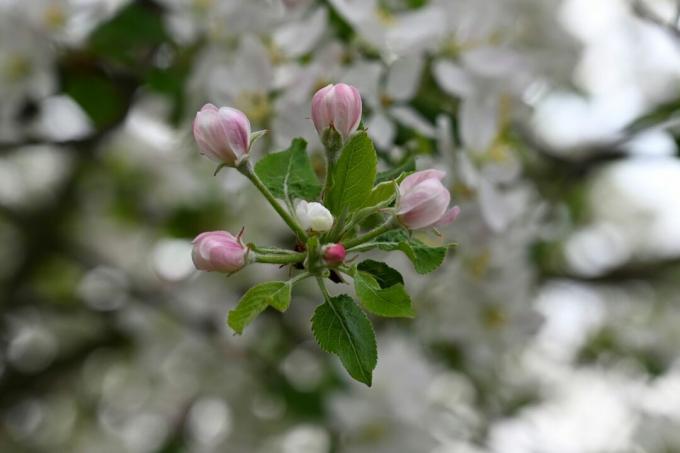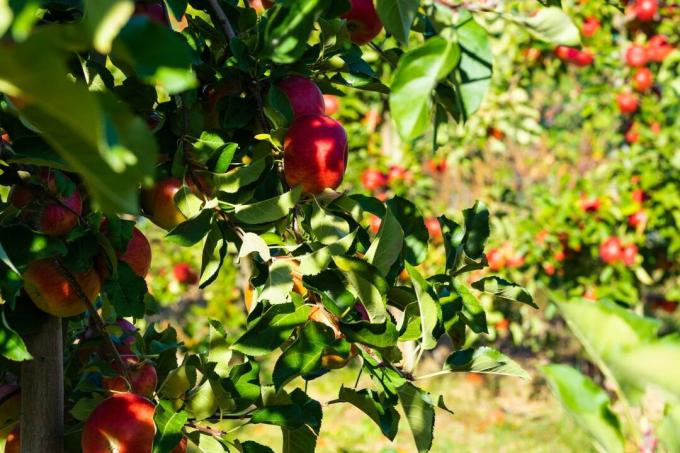The 'Merkur' apple has only been on the market since 2013 and is therefore a fairly new variety. Here we will tell you where the apple comes from and how you can grow it in your own garden.

If you are looking for an easy-care, robust and ornamental apple tree, you have come to the right place with the apple variety 'Merkur'. It is still a fairly new phenomenon on the market, but in many respects it can compete with, or even surpass, tried and tested strains.
contents
- Apple ‘Mercury’: profile
- History and origin of the apple 'Mercury'
- Taste and properties of the apple variety 'Merkur'
- Apple 'Merkur': Special features in cultivation and care
- Harvesting and use of the 'Merkur' autumn apple
Apple ‘Mercury’: profile
| synonyms | sweet topaz |
| fruit | Initially greenish-yellow, dark red as it matures |
| the taste | Sweet and sour, juicy, crunchy and firm to the bite |
| yield | High, early onset |
| harvest time | late August to early September |
| maturity | From September |
| shelf life | Until March |
| growth | Medium strong, upright |
| climate | Can be cultivated in many locations, not very sensitive to frost |
| diseases and pests | Little susceptible to scab and powdery mildew |
History and origin of the apple 'Mercury'
The apple variety 'Merkur' was only launched in 2013 as a new release. The 'Merkur' apple was bred at the Institute for Experimental Botany of the Czech Academy of Sciences in Prague. The apple variety is a cross between the varieties ‘topaz' and 'Rajka'. Especially because of its high resistance, but also because of the characteristic, highly aromatic, fruity-sweet taste, the 'Merkur' variety shows potential for domestic cultivation.
Taste and properties of the apple variety 'Merkur'
The medium-sized apples of the 'Merkur' variety have a characteristically slightly flattened, spherical shape and a pleasantly dry, non-greasy skin. The skin color of the apple is initially greenish yellow and later changes from the typical geranium to crimson Full color with distinct shell spots and a slight but noticeable russeting at the stem cavity covered.

The apples with their creamy-white to slightly yellowish flesh develop an aromatic, intense, juicy-sweet taste and have a crispy-fresh consistency that is firm to the bite. The taste of the 'Merkur' apple is rounded off by its unique, subtle olfactory note with the scent of plums.
Apple 'Merkur': Special features in cultivation and care
The 'Merkur' apple grows medium strong and very upright. Depending on which rootstock is used and how high it is grafted, the 'Merkur' apple is suitable as a standard, half-stem and bush form. Yields often begin at a young age, which is why the Bavarian State Institute for Horticulture and Viticulture recommends it especially for home and allotment gardens. However, the richly branched growth requires regular thinning cuts in spring. This promotes fruit quality, since the apples can develop better on the one hand and retain a high proportion of the red body color on the other. More tips about Pruning apple trees see this article.

The 'Mercury' apple tree prefers a sunny to semi-shady location with nutrient-rich and fresh to moist soil. The tree does not tolerate any waterlogging and therefore not too heavy, clayey soil; here he becomes susceptible to disease.
In late autumn or towards the end of winter you can have yours Plant apple tree. For ideal development, it is advisable to fertilize the apple tree in spring. For an even supply of nutrients, it is best to use a primarily organic long-term fertilizer, such as ours Plantura organic universal fertilizer.
For insect lovers, the 'Merkur' apple tree is a real specialty in spring: its characteristic, light pink, almost white flowers make it a real bee magnet in the flowering period from April to May Garden. Because of its medium-early flowering, the 'Merkur' apple is also ideal as a pollinator tree for apple varieties with the same flowering period as, for example, the 'Mars' or 'Golden Delicious‘. In addition, the variety is partially self-fertile, so it will bear some fruit even without a pollinator.

In terms of health and robustness, the 'Merkur' apple variety has a lot to offer, for example its low susceptibility to powdery mildew and scab. However, unfavorable locations - especially where soil tends to waterlogging - can cause some susceptibility to collar rot.
Harvesting and use of the 'Merkur' autumn apple
From September, when the fruit is ready to be picked, it is ready to eat almost immediately, so you can enjoy the delicious apples right after the harvest. For storage, a somewhat earlier harvest is required when the fruit is hard ripe. In this way, the 'Merkur' apple can be stored very well for a period of up to six months after harvest. In natural storage, in cool and humid conditions, the apple can retain its excellent bite well into March.

Because of its aromatic and sweet taste and its firm, juicy, crunchy flesh, the 'Merkur' apple is predestined for use as a dessert apple. Its full-bodied taste comes into its own when consumed directly. But the 'Merkur' apple can also fully develop its aroma when processed as juice or cider, as applesauce or as an ingredient in various cakes and desserts.
Haven't had enough of apples yet? We will show you in our article the best apple varieties for the home garden.



